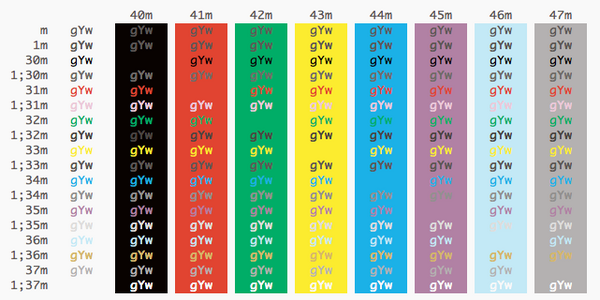
- ITERM CHANGE THEME INSTALL
- ITERM CHANGE THEME UPDATE
- ITERM CHANGE THEME MANUAL
- ITERM CHANGE THEME FULL
The provided template repo can be used to create a new user configuration repository on your GitHub account or cloned directly. We have created a template repository for easily making a user configuration file: Astronvim/user_example To begin making custom user configurations you must create a user/ folder. Language Server Protocol with Native LSP.Statusline, Winbar, and Tabline with Heirline.
ITERM CHANGE THEME UPDATE
Run :AstroUpdatePackages ( pa) to update both Neovim plugins and Mason packages ✨ Features Run :AstroUpdate ( pA) to get the latest updates from the repository Update AstroNvim Packages Run :Lazy sync to update and clean plugins Update AstroNvim I have a function proftoggle() that toggles between two iTerm profiles called. Run :Lazy clean to remove any disabled or unused plugins Run :Lazy update to apply any pending plugin updates Run :Lazy check to check for plugin updates
ITERM CHANGE THEME INSTALL
Node - Node is needed for a lot of the LSPs, and for the node repl toggle terminal ( tn)Įnter :LspInstall followed by the name of the server you want to installĮxample: :LspInstall pyright Install language parser Įnter :TSInstall followed by the name of the language you want to installĮxample: :TSInstall python Install Debugger Įnter :DapInstall followed by the name of the debugger you want to installĮxample: :DapInstall python Manage plugins . Python - python repl toggle terminal ( tp). bottom - process viewer toggle terminal ( tt). go DiskUsage() - disk usage toggle terminal ( tu). lazygit - git ui toggle terminal ( tl or gg). ripgrep - live grep telescope search ( fw). Terminal with true color support (for the default theme, otherwise it is dependent on the theme you are using). A clipboard tool is necessary for the integration with the system clipboard (see :help clipboard-tool for supported solutions). Tree-sitter CLI ( Note: This is only necessary if you want to use auto_install feature with Treesitter). ITERM CHANGE THEME MANUAL
Nerd Fonts ( Optional with manual intervention: See Recipes/Customizing Icons). Consider following me on Twitter if you want more content like this.If you are on AstroNvim v2.0 and are upgrading to AstroNvim v3.0 please see theĪstroNvim is an aesthetic and feature-rich neovim config that is extensible and easy to use with a great set of plugins ⚡ Requirements Now, you should be able to run the Toggle dark mode Automator application and see VSCode, as well as iTerm2 change themes accordingly! Thanks for reading. Here you can customize which theme should be used in which theme mode. Open the settings and search for Auto dark mode. Install the Auto Dark Mode extension by LinusU. It also doesn't have any built-in way of doing this, but there's a lot of extensions on the marketplace that can help us with this. The VSCode theme switching part is quite a lot easier. This will ask for permission and then run. Click Scripts > auto_dark_mode.py to finally run the script. Profile = await partial.async_get_full_profile()Īwait profile.async_set_color_preset(preset) ITERM CHANGE THEME FULL
# Fetch the full profile and then set the color preset in it. # Update the list of all profiles and iterate over them. Preset = await _get(connection, "Light Background") Preset = await _get(connection, "Smoooooth") # Themes have space-delimited attributes, one of which will be light or dark. #!/usr/bin/env python3Īsync with iterm2.VariableMonitor(connection,, "effectiveTheme", None) as mon:

After this, locate the file and open it inside of something like VScode, Vim, or Sublime, and paste the following content. Now, name the file however you want, but preferably something relevant, like auto_dark_mode.py.
Choose Long-Running Daemon as the script interval. Click Scripts > Manage > New Python Script in the MacOS menu bar. ITerm2 doesn't have any built-in feature for switching themes depending on the system theme setting, so to make this happen, we need to create a custom script for this. Hitting yes in the popup should make the system toggle its theme setting. Now, if you open your spotlight, or some other application launcher tool, you should be able to search for the newly created application, and once you run it, see a warning window show up, asking you whether you want to allow this application to run or not. 
Once it's in there, just add this piece of code, name it something reasonable, like Toggle dark mode, and save it somewhere you can find it later. Simply search for AppleScript in the search-bar, and drag it into the canvas. Now, we're going to choose an AppleScript block from the left-hand side menu.

Select Application, and click the blue button. Make sure you're also on somewhat of a new update of MacOS, to ensure that this is going to work. To do this, start by opening the Automator application. To start off, we'll create a MacOS Automator application that we can run from our spotlight, or something like Alfred, to be able to quickly change between light mode and dark mode in MacOS, manual, whenever we feel like it.







 0 kommentar(er)
0 kommentar(er)
